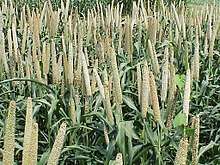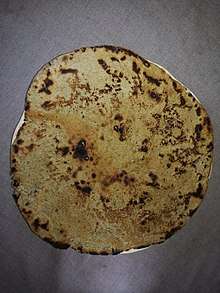Pearl millet
Pearl millet (Pennisetum glaucum) is the most widely grown type of millet. It has been grown in Africa and the Indian subcontinent since prehistoric times. The center of diversity, and suggested area of domestication, for the crop is in the Sahel zone of West Africa. Recent archaeobotanical research has confirmed the presence of domesticated pearl millet on the Sahel zone of northern Mali between 2500 and 2000 BC.[1] Cultivation subsequently spread and moved overseas to India. The earliest archaeological records in the Indian subcontinent date to around 2000 BC,[2] and it spread rapidly through Northern Indian subcontinent reaching South India by 1500 BC, based on evidence from the site of Hallur. Cultivation also spread throughout eastern and southern parts of Africa. Pearl millet is widely grown in the northeastern part of Nigeria (especially in Borno and Yobe states). It is a major source of food to the local villagers of that region. The crop grows easily in that region due to its ability to withstand harsh weather conditions like drought and flood. Records exist for cultivation of pearl millet in the United States in the 1850s, and the crop was introduced into Brazil in the 1960s.
| Pearl millet | |
|---|---|
 | |
| U.S. pearl millet hybrid for grain | |
| Scientific classification | |
| Kingdom: | Plantae |
| Clade: | Tracheophytes |
| Clade: | Angiosperms |
| Clade: | Monocots |
| Clade: | Commelinids |
| Order: | Poales |
| Family: | Poaceae |
| Subfamily: | Panicoideae |
| Genus: | Pennisetum |
| Species: | P. glaucum |
| Binomial name | |
| Pennisetum glaucum (L.)R.Br. | |
| Synonyms | |
|
Setariopsis glauca (L.) Samp. | |
Characteristics
With ovoid grains of 3 – 4 mm length pearl millet has the largest kernels of all varieties of millet (not including sorghum) which can be nearly white, pale yellow, brown, grey, slate blue or purple. The 1000-seed weight can be anything from 2.5 to 14 g with a mean of 8 g.
The height of the plant ranges from 0.5 – 4 m.[3]
Cultivation
Pearl millet is well adapted to growing areas characterized by drought, low soil fertility, and high temperature. It performs well in soils with high salinity or low pH. Because of its tolerance to difficult growing conditions, it can be grown in areas where other cereal crops, such as maize or wheat, would not survive. Pearl millet is a summer annual crop well-suited for double cropping and rotations.
Today pearl millet is grown on over 260,000 km2 of land worldwide. It accounts for about 50% of the total world production of millets.[4]

Culinary uses
Pearl millet is commonly used to make the flatbread bhakri. It is also boiled to make a Tamil porridge called kamban choru or "kamban koozh".
In Rajasthani cuisine bajre ki khatti rabdi is a traditional Rajasthani dish made with pearl millet flour and yogurt. It is usually made in summers to be served along with meals.
Common names
- In Africa: gero (Hausa), N!u-khwaba (Khwe language, Botswana), Arum (Borno Kanuri), Uwele (Kiswahili), Oka (Yoruba), mahangu (Mbukushu, Okavango language), saɲo (Bambara), gawri (Fula), babala, nyoloti, dukkin, souna, petit mil (French), heyni (Zarma), masago (Somali), mexoeira (Mozambique), biltug (Tigrinya), biltug (Blin), mhunga (Shona, Zimbabwe), inyawuthi (Northern Ndebele, Zimbabwe), lebelebele (Setswana, Botswana), zembwe (Ikalanga, Botswana), دْرُعْ dro'o (Tunisian Arabic), دُخن dokhn (Yemeni Arabic) mahangu (Namibia, Oshiwambo)
- In Australia: bulrush millet
- In Brazil: milheto
- In Europe: candle millet, dark millet
- In India: கம்பு (Kambu in Tamil); ("Kambam" in Malayalam); બાજરી or બાજરો (Bajri or Bajro in Gujarati); बाजरी (Bajri in Rajasthani and Marathi), ಸಜ್ಜೆ / ಕಂಬು(Sajje/kambu in Kannada); बाजरा (Bajra in Hindi, Urdu and Punjabi ["ਬਾਜਰਾ"]) and సజ్జలు (sajjalu in Telugu) and বাজরা ("ba:jra:" in Bengali).
- In Pakistan: باجرا (Ba'ajra, in Urdu, Kashmiri, Balochi, Pashto, Punjabi, Saraiki); ٻاجھري Sindhi,
- In USA: cattail millet (Pennisetum americanum)
- In Nepal: "जुनेलो” ( junelo)
Around the world
India
India is the largest producer of pearl millet. India began growing millet before c. 3300 BCE.[5] It is currently unknown how it made its way to India.[5] Rajasthan is the highest-producing state in India. The first hybrid of pearl millet developed in India in 1965 is called the HB1.
Kambu is the Tamil name of pearl millet and is an important food across the Indian state of Tamil Nadu. It is the second important food for Tamil people consumed predominantly in the hot humid summer months from February through July every year. It is made into a gruel and consumed along with buttermilk or consumed as dosa or idly.
Africa
The second largest producer of pearl millet and the first to start cultivation, Africa has been successful in bringing back this lost crop.
Sahel
Pearl millet is an important food across the Sahel region of Africa. It is a main staple (along with sorghum) in a large region of northern Nigeria, Niger, Mali and Burkina Faso. In Nigeria it is usually grown as an intercrop with sorghum and cowpea, the different growth habits, growth period and drought vulnerability of the three crops maximising total productivity and minimising the risk of total crop failure. It is often ground into a flour, rolled into large balls, parboiled, liquefied into a watery paste using fermented milk, and then consumed as a beverage. This beverage, called "fura" in Hausa, is a popular drink in northern Nigeria and southern Niger. Pearl millet is a food widely used in Borno state and its surrounding states, it is the most widely grown and harvested crop. There are many products that are obtained from the processing of the crop.
Namibia
In Namibia, pearl millet is locally known as "mahangu" and is grown mainly in the north of that country, where it is the staple food. In the dry, unpredictable climate of this area it grows better than alternatives such as maize.
Mahangu is usually made into a porridge called "oshifima" (or "oshithima"), or fermented to make a drink called "ontaku" or "oshikundu".
Traditionally the mahangu is pounded with heavy pieces of wood in a 'pounding area'. The floor of the pounding area is covered with a concrete-like coating made from the material of termite mounds. As a result, some sand and grit gets into the pounded mahangu, so products like oshifima are usually swallowed without chewing.[6] After pounding, winnowing may be used to remove the chaff.
Some industrial grain processing facilities now exist, such as those operated by Namib Mills. Efforts are also being made to develop smaller scale processing using food extrusion and other methods. In a food extruder, the mahangu is milled into a paste before being forced through metal die. Products made this way include breakfast cereals, including puffed grains and porridge, pasta shapes, and "rice".[7]
Research and development
Recently more productive varieties of pearl millet have been introduced, enabling farmers to increase production considerably.[8]
To combat the problem of micronutrient malnutrition in Africa and Asia, a study of serving iron-biofortified pearl millets which is bred conventionally without genetic modification to a control group is proved to have higher level of iron absorbance by the group.[9]
Around 1000 pearl millet genotypes, including 31 wild genotypes are sequenced to grasp the genetic diversity of this staple crop to aid breeding by enriching the genetic material. A reference genotype of pearl millet (Tift 23D2B1-P1-P5) has been fully sequenced, which holds around 38,579 genes. Some of these genes are for wax biosynthesis, which is known to be involved in tolerance to abiotic stresses in pearl millet.[10] ICRISAT is currently evaluating crop wild relatives and will introgress abiotic tolerant traits into cultivated genotypes and make them available for pearl millet improvement.
Gallery
 A scientist in Zimbabwe checks a pearl millet crop.
A scientist in Zimbabwe checks a pearl millet crop. Mahangu pounding
Mahangu pounding
.jpg) This flour mill in Tanzania mills pearl millet.
This flour mill in Tanzania mills pearl millet. Pennisetum glaucum
Pennisetum glaucum
MHNT
References
- Manning, Katie, Ruth Pelling, Tom Higham, Jean-Luc Schwenniger and Dorian Q Fuller (2010) 4500-year-old domesticated pearl millet (Pennisetum glaucum) from the Tilemsi Valley, Mali: new insights into an alternative cereal domestication pathway. Journal of Archaeological Science 38 (2): 312-322
- Fuller, D.Q. (2003). African crops in prehistoric South Asia: a critical review. in Neumann, K., Butler, A., Kahlheber, S. (ed.) Food, Fuel and Fields. Progress in Africa Archaeobotany. Africa Praehistorica 15 series. Cologne: Heinrich-Barth-Institut, 239-271.
- "Sorghum and millet in human nutrition". Food and Agriculture Organization of the United Nations. 1995.
- Millet Archived 2007-07-11 at the Wayback Machine. Consultative Group on International Agricultural Research.
- Singh, Purushottam (1996). "The origin and dispersal of millet cultivation in India" (PDF). Retrieved October 9, 2017.
- "Archived copy". Archived from the original on 2013-02-21. Retrieved 2006-05-19.CS1 maint: archived copy as title (link)
- "Enhancing food security in Namibia through value-added products". Council for Scientific and Industrial Research. March 2003. Archived from the original on 6 December 2005. Retrieved 4 March 2012.
- Board on Science and Technology for International Development; Office of International Affairs; National Research Council (1996-02-14). "Pearl Millet: Subsistence Types". Lost Crops of Africa: Volume I: Grains. Lost Crops of Africa. 1. National Academies Press. p. 108. ISBN 978-0-309-04990-0. Retrieved 2007-11-07.
- Munyaradzi, Makoni (29 August 2013). "Biofortified pearl millet 'can combat iron deficiency'". SciDev Net. Retrieved 29 August 2013.
- K Varshney, Rajeev; Shi, Chengcheng; Thudi, Mahendar; Cedric, Mariac; Wallace, Jason; Qi, Peng; Zhang, He; Zhao, Yusheng; Wang, Xiyin (2018-04-05). "Erratum: Pearl millet genome sequence provides a resource to improve agronomic traits in arid environments". Nature Biotechnology. 36: 368–368. doi:10.1038/nbt0418-368d.
External links
- Lost Crops of Africa: Volume I: Grains, Chapters 4-6 - released by the National Research Council in 1996
- Pearl Millet Thresher IDDS project
| Wikimedia Commons has media related to Pennisetum glaucum (Pearl millet). |